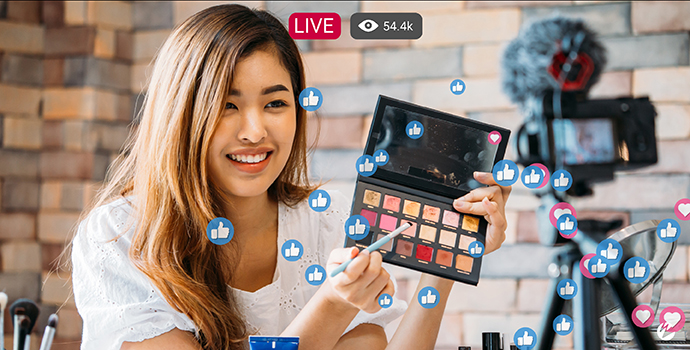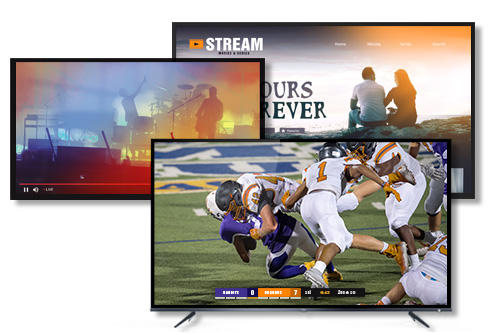8 Ways To Approach Live Streaming Monetization

Live streaming monetization comes in a variety of shapes and sizes. Some would be considered classic, such as advertising. Others, such as live commerce, are still emerging methods. Whether you’re an individual streamer, a startup working on wearable devices, or a company developing the next Netflix-sized service, there are multiple ways you can make money in the live streaming industry. Let’s start with the most innovative and work our way back to the tried and true.
Productization
Innovators are bringing live streaming to products in many industries. The two with the lion’s share of examples are surveillance and health. Explore the existing ways we’ve welcomed new live streaming products into our lives, and maybe you’ll be inspired to unlock the next big niche.
Surveillance
At home, we’ve seen a huge increase in Internet of Things (IoT) devices that are focused on security and surveillance. Homeowners no longer have to go through an expensive security company to set up video surveillance. Now, the barrier to entry is only about $20 for a single Wyze camera and 14 days of cloud video storage. Companies have started with simple home security camera systems, added live streaming to the mix, then expanded the way we think of home surveillance by developing lots of new devices.
Smart doorbells, such as Ring and Nest, are a well-known use case for home security. Of course we’d all like to see who’s at the door — and when. Now, we’re experiencing the evolution of live streaming at home to include pet cameras, baby monitors, and even devices for senior care. The idea behind all three of these products is that people can check in on their loved ones without having to actually be there. These quality-of-life enhancers rely on two-way video and audio so you can remind your grandmother to take her medication, soothe your lonely pet, or listen to your baby’s breathing from afar — without their needing to learn how to use a device.
Monitoring is just as popular outside of the home as well. In the past couple of years, we’ve started seeing the term “smart cities.” This is when several different technologies are brought together to improve resources and services in an urban area. One of the newest technologies is intelligent transportation systems which use video to monitor traffic, alter the timing of traffic lights, and send emergency vehicles when needed.
Health
Like surveillance, live video has become a major part of both home fitness and the health care industry. Fitbit started offering wristband trackers in 2013, allowing us to monitor our physical activity, heart rate, and sleep. According to the Pew Research Center, about 21% of U.S. adults regularly wear a smartwatch or fitness tracker. That’s some fast, widespread adoption. The success of fitness trackers and smartwatches has spurred companies to expand farther into the health and fitness world. Connected exercise equipment companies such as Peloton, Tonal, and Mirror now offer live workout classes through the machines themselves. There are currently more than 10 products on the market that are designed to provide all the perks of exercising in a class setting or with a personal trainer — but at home.
Hospitals are where the most interesting use cases that marry health care and live video streaming have been popping up. Streaming is a great asset for both new-hire training and medical education. Camera-aided surgery is a huge boon to the medical industry because these robotic arms provide a better view and make less invasive operations possible. There are also health care monitoring solutions emerging, such as Child Health Imprints’ IoT-enabled device for neonates (see the video below) and AngelEye Health’s communication device for newborn babies in the neonatal intensive care unit (NICU).
Interactivity
Interactive live streaming includes many different industries that all have one thing in common: interaction between the streamer and the viewers. There are at least three proven methods of live streaming monetization when it comes to interactive streaming, including live commerce, sponsorships, and donations.
Live Commerce

Live commerce is the newest evolution of online shopping. Viewers watch models and influencers as they showcase products, and they learn more about the products by interacting with the models themselves. The services combine an in-person shopping experience with online shopping, bringing viewers the best of both worlds. Live commerce is most popular in China, South Korea, and the rest of the Asia-Pacific (APAC) region. In the U.S., Amazon Live and JTV (Jewelry Television) have joined China’s Taobao and South Korea’s LF Corp.
Although jewelry, fashion, accessories, and skincare are the most popular products sold via live commerce, there’s no reason why the idea can’t expand to any number of products. Furnishings, cars, gardening supplies, crafts — anything we buy online could be enhanced with an expert taking questions or walking a shopper through a purchase using an app or website.
Sponsorships
Individual streamers can gain sponsorships if they have enough average viewers on their chosen platform. Twitch, for instance, claims to have more than 45,000 partners for its 7.8 million active streamers to work with.
Streamers are sponsored by brands that include energy drinks, computer peripherals such as keyboards, and even food delivery services such as Postmates. A lot of the agreements hinge on the streamer simply using the products or services during streams. An example would be a streamer with a Red Bull–branded refrigerator in the background or with Razer–branded headphones on. Additionally, sponsorships can come in the form of an entirely sponsored stream, where the streamer repeatedly plugs a soon-to-be-launched game. On an even larger scale, there are sponsorship deals for esports competitions in the same way that there are for traditional sports.
Donations
Again, this tactic is geared toward individuals, but small enterprises or nonprofits could easily pull this off as well. Live stream philanthropy has had to gain traction this year as a reaction to the COVID-19 pandemic. Remember the telethons of your (or your parents’) youth? Those are moving online now and even replacing live events.
On a broader scale, YouTube streamers use a service called Patreon to get donations from their viewers to fund their content creation and increase their production value. Patrons give money every month to view extra content not publicly available, get regular content sooner than nonpatrons, and receive personal thanks from the streamers. Viewers typically develop what’s called a “parasocial relationship” with their favorite streamers — they feel a connection with them on a personal level, which entices them to donate money to keep the streams coming. This is one of the easiest live streaming monetization methods to set up.
Video on Demand
Video on Demand (VOD) is popular because it offers an array of options for live streaming monetization. There are three key ways to make money when it comes to VOD, and they’re prevalent enough to have their very own acronyms: SVOD, TVOD, and AVOD.

Subscription Video on Demand (SVOD)
Subscription video on demand is exactly what it sounds like. Video content is available to stream with a subscription. Netflix, Hulu, and Disney+ are some of the biggest examples of successful SVOD services. The success of these companies has led many others to try their hands at subscription video on demand with varying degrees of success. There appears to be room for new streaming subscription services — as long as you choose a viable niche. For instance, there’s the potential for new services based on the genre of content being delivered. Imagine an SVOD service that only delivers live concerts or lets people explore famous monuments from the comfort of their couches. The market is becoming crowded quickly, however, and not all niches are working out, as is evidenced by the famous failure of Quibi.
Transaction Video on Demand (TVOD)
Traditionally, transaction video on demand refers to pay-per-view content. The content is available to be viewed at any time, and users pay a one-time fee to watch each piece. It’s been a popular way of getting extra revenue out of newly released movies after they leave the box office.
Lately, and especially since the beginning of the COVID-19 pandemic, TVOD has grown to include more event-based content, such as live fights, concerts, and movie releases. The closure of theaters and stages has increased the popularity of transaction video on demand, and we’ll see if this trend continues and expands to include more types of content.
Ad-Based Video on Demand (AVOD)
We’re all familiar with advertising and how versatile this way of earning revenue can be. For more than half a century, ads have shown up alongside video content. This is no different in live-streamed or video-on-demand content. Interestingly, AVOD is often offered to viewers as a cheaper alternative to SVOD or TVOD. Hulu, for example, has one service plan with ads and a more expensive plan without ads.
One of the more useful things about ad-based video on demand is how targeted ads can be nowadays. Companies can discern a lot about their users, and they’re using that information to their advantage. Viewing habits themselves can even influence which types of ads a customer receives.
Conclusion
However you choose to approach live streaming monetization, you’ll need reliable software, services, and hardware. Wowza is the streaming power behind companies and products that fit into all the different categories discussed here. We’d love to work with you on the next IoT streaming product, subscription video-on-demand service, or interactive video experience.




